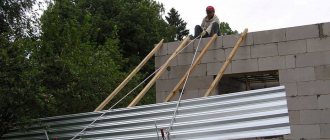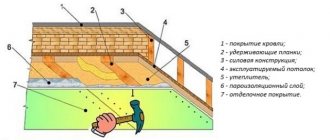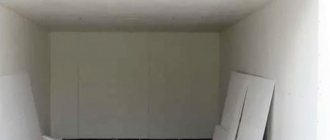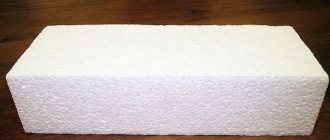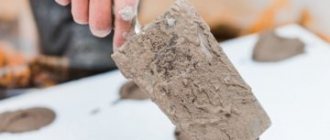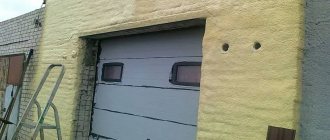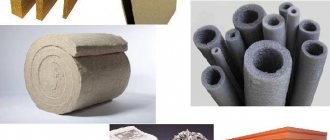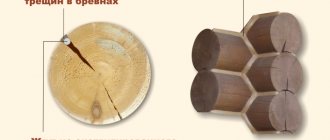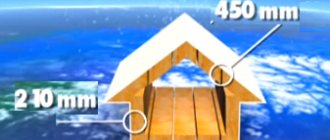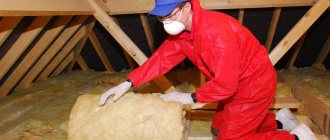Why insulate walls
The enclosing structures of buildings for cars are made of large-block materials, for example, cinder block or gas block, less often of brick. Depending on the method of laying the products, the thickness of such walls will range from 12 to 30 centimeters. This width is not enough to protect the room from the penetration of cold air. Even when installing a heating system, the difference between the air temperature outside and inside the building will lead to condensation.
There is no need to artificially increase the temperature in the garage to high levels. After a car enters a warm room from a cold street, condensation will certainly appear on its surface, which will lead to corrosion of the metal. Thermal insulation of the garage should be selected and installed in such a way that the difference in temperature in the room and outside the window is minimal. The optimal performance for a car is considered to be +5 degrees.
Note! When insulating building envelopes, motorists seal all cracks, including ventilation holes. It is prohibited to clog exhaust pipes; they are used to remove accumulated moisture and help remove carbon monoxide from the room.
What material to use for this?
In fact, the question here will be solely in the budget allocated for the event. If savings are needed, then there is only one option - polystyrene foam. If you have a little more money, then mineral wool is the optimal solution. Exotic sprayed polyurethane foam will surpass the main types of thermal insulators in properties and efficiency, but it will be the most expensive option and, besides, you won’t be able to create such thermal protection with your own hands; you need to have certain knowledge of the technology, as well as special equipment. Therefore, there are few options:
The last option, as already mentioned, is too expensive and it is not easy to implement such insulation, even with the necessary knowledge and tools. Therefore, we will consider the most affordable and simple types of thermal insulation.
What materials are suitable for insulating a garage?
Mineral wool
An important advantage of using mineral wool to insulate a garage with your own hands is the ability to create a “breathable” insulation layer. The fibrous structure of the cotton wool does not interfere with the natural circulation of air inside the garage; exhaust gases, evaporation of fuel and other technical liquids, which are always stored in abundance on the shelves, will quickly erode outside without stagnating or poisoning the air. An additional argument in favor of cotton wool can be its non-flammability. In a garage where there is a lot of flammable stuff, this can be a deciding factor.
Among all the variety, it is recommended to choose basalt or stone wool. It has the best thermal conductivity of 0.03-0.1 W/m °C and at the same time serves as excellent sound insulation.
The easiest way to lay mineral wool is in the form of semi-rigid mats. The mats fit tightly into the spacer of the frame mounted from timber or galvanized profile on the internal surfaces of the garage: walls, ceiling, gates
And don’t forget that in order for mineral wool to preserve its thermal insulation properties, it is important to use a vapor barrier membrane that will remove excess condensation and prevent moisture from accumulating inside the insulation
Styrofoam
Polystyrene foam is perhaps the most popular material for do-it-yourself garage insulation. It can be cut and processed without problems using simple tools, such as a knife. It has extremely low thermal conductivity - only 0.03-0.04 W/m °C. And it's cheap.
Although there were some downsides. Polystyrene foam noticeably “eats” the internal space and is also flammable; it is better to keep a fire extinguisher in a visible place.
You can mount foam sheets on internal surfaces using polystyrene glue, polyurethane foam or plastic dowels (they will require sheathing). The optimal thickness of the insulating layer is 50-100 mm. The joints must be sealed with polyurethane foam.
Thermal insulation plaster
In addition to the binder element, gypsum or cement, such plaster contains porous materials - quartz sand, vermiculite or expanded polystyrene, which provide heat-insulating properties. Thermal conductivity coefficient of “warm” plaster: 0.065 to 0.13 W/m °C.
Heat-insulating plaster is applied to the walls and ceiling using standard technology: installing beacons, preparing the mixture, applying the mixture to the surface, leveling. It is recommended to apply one or two layers up to 50 mm thick on the walls, and one layer of 5-30 mm on the ceiling.
It is best to use insulating plaster for garages made of brick or cinder blocks. It will insulate the room and allow you to level the walls and ceiling.
Thermal insulation paint
Thermal insulation paint is a new word in room insulation. It is a polymer composite filled with hollow ceramic microspheres.
Read more about the structure and features of thermal insulation paint in the article All about ultra-thin ceramic thermal insulation
The thermal conductivity of the paint is about 0.065 W/m °C, which is approximately comparable to “warm” plaster. Only the insulation layer will be only 2-4 mm. What a saving of internal space.
In its finished form, the insulation is a liquid consistency, which is applied like regular paint, using a brush, roller or spray gun. This method of application will be especially appreciated by owners of metal garages. After all, the internal surfaces of such garages have a complex profile due to various corners, beams and protruding fasteners, and it is quite difficult to attach a tight-fitting layer of insulation to them. But painting the surface of any profile, no matter how complex, is not difficult.
However, it would be a mistake to assume that a thin layer of heat-insulating paint will create the desired microclimate in the garage. Yes, it can replace a fairly thick layer of traditional insulation. But for the desired result - +5°C inside the garage - you will still need to supplement it with a layer of another insulation, mineral wool or polystyrene foam.
The most common insulation materials
Mineral wool. This material has been used in room insulation for about 50-60 years. Mineral wool itself has several types. Basalt mineral wool is more suitable for insulation. It does an excellent job of blocking outside noise and retaining heat by keeping air circulating in the garage.
Mineral wool is produced in the form of soft, medium-hard and hard mats. It is better to purchase rigid types of insulation, as they are the most durable and do not allow moisture to pass through as much. In addition, rigid mats are easier to attach, and in the future they will not slide off the walls of the garage.
The advantage of this material is that it does not require special skills or tools to work with it.
Reference! Mineral wool is very afraid of moisture. Therefore, when purchasing this insulation, it is necessary to purchase waterproofing materials.
Glass wool. This is the cheapest heat-insulating material. This is where its advantages end. However, garages insulated with glass wool retain heat well inside. It is made from waste from the glass industry, so it has a lot of small glass elements. To work with this insulation, you must wear gloves, outerwear and goggles, since when it comes into contact with the skin or eyes, its particles cause discomfort, itching or injury.
Glass wool has a rather unpleasant odor. It needs to be well protected from moisture, because when wet, the cotton wool crumples and completely loses its heat-insulating properties.
Styrofoam. It is also a popular material for insulating heat indoors. Polystyrene foam is cheap and can be used for 10 years. It does not rot, is not afraid of fungus, the material is light and convenient, since it can be used to insulate walls alone.
But foam plastic also has significant disadvantages. It practically does not allow air to pass through, so good ventilation should be ensured in the garage. The joints of the plates must also be carefully coated with sealant, otherwise condensation will accumulate in the cracks. It can withstand chemicals, but can be damaged when exposed to direct sunlight. In addition, rodents may suddenly appear in the foam. They are capable of destroying the entire thermal insulation layer in a few years. Therefore, it is worth thinking about measures to protect against mice.
Penoflex (extruded polystyrene foam). Some experts claim that this is the best option for insulating rooms. It is cheap and even easier to install than polystyrene foam - its joints do not need to be sealed, since they have special grooves in the shape of the letter “L”. It is easy to cut and glue.
It copes well with the assigned thermal insulation task. It is worth noting that the material has a very low moisture absorption rate, which means that penoflex does not get wet and is not afraid of seasonal temperature changes. Many say that this insulation can be used for up to 50 years.
Penoflex is not susceptible to rotting and insects do not appear in it. In addition, the material has excellent sound insulation. Therefore, this insulation can be used for both internal and external insulation.
Polyurethane foam. It is popular due to its resistance to weather conditions. After application, the material stretches and fills all voids, and also reliably adheres to the wall and ceilings, so it does not need to be additionally sealed. In order to insulate a garage using polyurethane foam, it is necessary to use special equipment that sprays the material onto the walls in liquid form, after which it hardens and forms continuous layers of hydro- and thermal insulation. In addition, the material is not flammable and can be used for up to 50 years.
Most likely, to apply polyurethane foam you will have to resort to the help of specialists. Today, there are many companies that insulate garages using material. Therefore, when using polyurethane foam you will have to spend a lot of money.
Reflective thermal insulation. It's a kind of foil with an extra layer. It is quite effective as it reflects heat into the room.
The thickness of the reflective layer can reach up to 50 mm. It reflects infrared radiation well, so it is used mainly for heated rooms.
Warm plaster. It can be used if the garage walls are made of brick or cinder blocks. The plaster contains heat-protective elements such as vermiculite, processed sawdust or expanded polystyrene.
To be effective, you will have to apply a thick layer of this material, and this can greatly increase the load on the walls of the garage.
Warming paint. The layer of this paint is 1 mm. But the thermal insulation layer can be compared in its qualities to mineral wool, whose layer thickness is 50 mm. Paint is made using polymers to which synthetics are added. It is not at all difficult to apply to the surface.
Why do you need to insulate your garage?
The temperature regime that has a positive effect on the condition of the car differs significantly from the one in which a person is comfortable. If in residential premises the standard is to maintain the air temperature at +20-22 degrees Celsius, then for storing a car +5 degrees is considered the most optimal. At this temperature, almost no condensation forms on metal parts, causing destructive corrosion.
Therefore, to create a microclimate suitable for technology in the garage, other approaches to insulation are used. After all, the desire to recreate room conditions in the garage using insulation and heating devices will harm the vehicle. For example, in winter, when entering a heated room from the cold, the car will instantly fog up, the air humidity will increase, and the car will sit in such a warm-humid fog all night.
How to properly insulate a garage? Let's figure it out.
Insulating a garage with foam plastic from the inside
It is advisable to maintain an optimal microclimate in the garage. If you can properly insulate a building, you will significantly reduce heating costs, while the conditions will be quite comfortable for work, technical inspection and car repairs. For example, in unstable weather with average temperature values, in spring and autumn, you will not need to worry about heating at all, and in the cold winter, energy consumption will be significantly less. The optimal solution is to insulate the garage from the inside with polystyrene foam. This method is quite popular and trusted even by experienced car enthusiasts.
The secret of polystyrene foam is its cost-effectiveness and high efficiency as insulation. At the same time, you can also save on construction work, since the garage owners will be able to handle the installation of such a layer of insulation on their own. Today we will learn in more detail how to insulate a garage with polystyrene foam, how best to work with the material, and how its varieties differ from each other.
Types of thermal insulation materials for garage walls
In the modern construction market there is a huge selection of insulation materials. Let's consider the characteristics of the most popular thermal insulation materials:
- Mineral wool is supplied to stores in the form of rigid mats with a density of up to 240 kg/m3. Such products are characterized by high resistance to fire and allow water vapor to pass through their structure (breathe). The only disadvantage of using basalt wool is the need to install a vapor barrier film, which will protect the product from getting wet. When exposed to moisture, the insulation loses its properties.
- Glass wool is considered a cheaper analogue of mineral wool. Such products consist of hard and prickly fibers, so you need to wear glasses and gloves when working with insulation. After getting wet, the mats clump and become heavy, so glass wool needs to be protected from moisture penetration by laying special films or foil.
- Polystyrene foam is considered the most convenient thermal insulation material to use. The products are not afraid of dampness, can be easily cut into pieces with a regular hacksaw, and are affordable. Insulation of a garage can be done using an analogue of polystyrene foam, polystyrene foam, which will last up to 40 years. The main disadvantages of the products in question are considered to be flammability and low resistance to sunlight. Foam plastic unprotected by plaster turns yellow and crumbles.
- Another insulation for the garage, warm plaster consists of vermiculite or foam balls. Such materials have good heat-insulating qualities, but to obtain maximum effect, a thick layer of mortar must be applied to the walls.
Materials used for garage insulation
How to insulate a metal garage from the inside is a question that faces the user when the garage is built, and the effect of its use does not meet the requirements for the conditions of storage and operation of the vehicle.
To insulate such structures, the following heat-insulating materials can be used: polystyrene foam, mineral wool, penoizol, polyurethane foam.
How to insulate an iron garage from the inside is decided by each user individually, based on personal preferences, the ability to do this work independently and the properties of the material used.
How to insulate a garage: a comparative review of materials
| dignity | flaws |
| Styrofoam | |
|
|
| Mineral wool | |
|
|
| Penoizol | |
|
|
| Polyurethane foam | |
|
|
Polyurethane foam for garage insulation
And a few words about polyurethane foam, the thermal conductivity of which is 0.019 W/m K. That is, it is better than polystyrene foam. But it is more expensive and requires special equipment to apply it. Until recently, such equipment consisted of huge containers and a compressor. Today, manufacturers offer compact devices whose weight does not exceed 30 kg.
These are two cylinders and a mini-compressor with hoses and nozzles. The cylinders contain two components that are connected and supplied through hoses under pressure
The applied layer is thin (15-20 mm), please note - it is continuous, without seams or joints, and is more effective than many modern thermal insulation materials used for insulating garages. But if we compare the cost, then it is inferior to the same polystyrene foam
Although good insulation cannot be cheap.
Insulation of a metal garage with polyurethane foam
There are several effective and inexpensive technologies for insulating iron garages. But, as practice shows, polystyrene foam is most often used if the conversation turns to DIY processes. There are no restrictions or contraindications in the use of this material. At the same time, the insulation has a number of good technical characteristics, plus the low price of the product itself.
Liquid thermal insulation
Common liquid insulation materials are heat-insulating paints Asstratek and Corundum. This is an expensive but quick way to insulate a metal garage from the inside.
Might be interesting
Thermal insulation
How to insulate a roof from the inside and not make mistakes?
Thermal insulation
Roofing and drainage: heating rules
Thermal insulation
Insulated Swedish stove: pros and cons
Thermal insulation
Penoizol: self-production
A 1mm layer replaces a 50mm mineral wool slab. Apply paint with a brush or roller. The coating is moisture resistant and durable. Service life up to 15 years. To provide a 1mm thick coating, 1 liter of paint per 1 m2 is required. Experts recommend application in two layers.
How to insulate garage doors
Not everyone knows how to properly insulate a garage from the inside. Effective and reliable thermal insulation of walls will not be enough, because a significant amount of heat escapes through the gate. The lack of insulation in this design will not allow the garage to warm up to the required temperature levels. At the initial stage of work, a hole is made in one of the doors and the doors are inserted. To reduce heat loss, a curtain made of thick fabric is fixed in this place.
A transparent polyethylene film with a minimum thickness of 0.8 millimeters will help to insulate the entire plane of the gate. This material is cut into strips 20-30 centimeters wide and fixed above the opening, so that the lower edge does not reach the floor surface by 1-2 centimeters. The strips are secured to a wooden beam using staplers. This insulation is very effective - when entering the garage, the driver will see the surrounding space. In addition, narrow strips of polyethylene will smoothly flow around the car and return to their original position.
Some car enthusiasts insulate the inside of their garage doors with polystyrene foam. To do this, a sheathing of wooden blocks is installed on the inside of the structure and the voids are filled with polystyrene foam slabs. To prevent cold air from penetrating through the gaps, the joints of the thermal insulation are taped with tape.
To eliminate drafts entering through the gates, it is necessary to replace the rubber seals. Condensation forms where the thermal insulation comes into contact with the metal surface. To prevent destruction, the steel is treated with paint or other anti-corrosion compound. Waterproofing substances are also applied to other surfaces.
The wooden guide elements of the frame are coated with a primer or heated drying oil, which will protect the material from rotting and exposure to fungus. After laying the foam, the surface is cleaned. Garage doors are finished with OSB boards or thin boards. It is not advisable to use moisture-resistant products for this, for example, gypsum board.
How to insulate a metal garage with your own hands
Before you begin work on insulating the garage, you need to decide what material will serve as thermal insulation. The selection criteria, in this case, will be the advantages and disadvantages of each of the materials given above, as well as their cost and the possibility of purchasing at the user’s place of residence.
To perform the work, you will need hand and electric tools, thermal insulation, lumber or metal profiles, fasteners (screws, bolts, clamps, etc.), materials for waterproofing and vapor barrier of building structures, sealing agents (spray foam and tape).
When insulating a metal garage from the inside, depending on the material chosen, the work is performed differently. Therefore, we will consider several insulation options for different building elements of one structure.
To insulate the ceiling we use mineral wool.
Important: when insulating cold buildings, you need to remember that the greatest amount of heat “leaves” from the room through the ceiling!
- Guides (lathing) are mounted along the ceiling. This can be lumber or metal profile.
- The sheathing is laid in increments equal to the width of the insulation boards.
- A layer of waterproofing is laid down. For this you can use roofing felt or polyethylene.
- Mineral wool is placed between the guides and fastening is done using mastic or glue.
- The seams between the plates are sealed.
- A layer of vapor barrier is laid, over which the exterior finishing is carried out (plasterboard, lumber).
Insulation can be done in a similar way using polystyrene foam.
To insulate walls we use penoizol or polyurethane foam
Depending on the type of penoizol, work can be performed in the following sequence:
- When used in liquid form:
- A frame made of metal or wood is mounted on the surface of the walls.
- A fine reinforcing mesh is stretched over the frame elements.
- The prepared surface is filled with foam insulation.
- A layer of vapor barrier is laid.
- The surface of the walls is finished (plaster, drywall, lumber, various types of plastic).
Important: when insulating using penoizol, a prerequisite is to lay a layer of vapor barrier, which ensures that moisture is cut off from inside the room.
- When used in the form of slabs, the work is performed as in the case of wall insulation using mineral wool. Penoizol sheets are attached with glue or adhesive mastic.
Recommendation: Using polyurethane foam when doing the work yourself is a difficult task that requires special equipment. It is recommended to involve specialized organizations or specialists who have the skills to work with this material to carry out this work.
- For external insulation, we use Astratek thermal insulating polymer coating.
- The metal of the walls and roof is cleaned of foreign objects and elements of contamination.
- The surface is cleaned of rust.
- It is degreased.
- Using a brush or roller, apply the polymer coating used in two layers.
Insulation of walls from the inside
The choice of insulation, as well as the technology for insulating enclosing structures, will depend on the material from which the enclosing structures are made. Many car enthusiasts are interested in the question of how to insulate a brick garage. First you need to clean the surface from dust and dirt, mount a frame into which the thermal insulation will be installed.
The sheathing is made from a plasterboard profile. The guides are fixed to the wall with dowels, which are driven in every 30 centimeters. The distance between the guides must correspond to the width of the insulation boards. To finish the walls, you can use sheets of plasterboard or asbestos fiber. It is better to use the latest products, because they have a high degree of fire resistance compared to similar materials.
Advice! Asbestos fiber is quite fragile; to prevent its destruction as a result of various mechanical influences, reduce the pitch between the frame guides.
Insulation of garage walls from the inside is carried out using mineral wool or other products made in the form of slabs. In this case, the mats are inserted between the guides, their position is fixed using special hooks. After this, they begin to install the vapor barrier membrane, which should be connected to the cotton wool insulation.
We also insulate the garage from the outside, using warm plaster or special paint. Carrying out such work shifts the dew point, which will protect the walls from moisture penetration and further freezing. The owner of the building must install forced ventilation. This system is designed for intensive air exchange.
Insulating a garage with foam plastic is suitable for insulating metal walls. Expanded polystyrene boards are fixed to the base surface using an adhesive mixture. To securely fix the thermal insulation, it is necessary to first clean and degrease the metal. The sheets are fixed to the walls with the seams aligned, and polyurethane foam is poured into the gaps. Polystyrene foam is subject to combustion, so a thin layer of plaster must be applied to its surface.
Metal garage walls are often insulated with polyurethane foam or special paint. If there are voids between the frame, insulation is carried out using penoizol. The liquid mass penetrates into the wall through special holes. The foam clings well to surrounding surfaces, hardens, turning into high-quality and reliable thermal insulation.
Which side to insulate the garage from?
It is clear that there are two sides to the walls: external and internal. It is optimal to insulate the building from the outside in order not to reduce the internal space of the garage. This option can only be used if the garage is a separate building. That is, you can approach it from any side and carry out thermal insulation processes.
External insulation is a fairly large list of materials and technologies. That is, there are no restrictions in this regard. But each method requires a special approach, especially in terms of attaching insulation. Therefore, one of the easiest ways to insulate a garage is to line it with bricks. Of course, half a brick is not the most reliable protection, but the temperature inside the building will be clearly higher than outside.
The second method, which uses brick, is to pre-insulate the walls of the garage structure, and then line the insulated surfaces with brickwork. But here you can use any heat-insulating materials with low moisture absorption. For example, polystyrene foam boards. They are simply glued to the metal walls of the garage structure using a special adhesive composition, which is sold in cans. And then they put brick cladding on top.
Metal garage lined with brick Source domovita.by
This option for thermal insulation of metal walls requires additional costs for the construction of a small base for brickwork. Usually this is a small foundation slightly wider than the width of the brick. It can be superficial or shallow.
In principle, you can insulate a metal garage in exactly the same way, using other finishing materials. For example, siding. True, you will have to build a frame under it, which must somehow be attached to the metal sheets of the garage structure. The simplest option is to use self-tapping screws, for which you will need to make through holes in the walls with a diameter slightly smaller than the diameter of the fasteners. Note that assembling the frame is a rather labor-intensive operation that will take a lot of time.
You can fasten the sheathing using wire, for which you need to drill two holes on each side of the frame element. The two ends of the wire are inserted into the holes from inside the garage, and a twist is made on the sheathing, thus pressing the wooden block to the metal surface.
It is between the elements of the sheathing that the heat-insulating material is laid. And siding is mounted on the frame itself. The photo below just shows a garage, insulated and covered with siding.
Warm garage covered with vinyl siding Source metgar.ru
Today, so-called thermal panels are very popular. This is insulation onto which finishing slab material is glued. A striking representative of this category are polystyrene foam panels on which clinker tiles are glued. This is a universal finishing material in terms of its installation. That is, it can be installed on the lathing, glued to the walls or secured with self-tapping screws.
In general, using the technology of frame insulation of garages from the outside, endless possibilities open up. Because any slab, sheet or slatted material can be installed on the sheathing. That is, the insulation can be covered from the outside with a large number of materials, and not necessarily finishing ones. For example, you can use corrugated board, lining, OSB boards with subsequent painting, moisture-resistant plasterboard with the application of decorative plaster and other expensive and not very expensive facing materials.
Garage made of metal structures, insulated and lined with corrugated sheets Source fireswirl.co
I would like to add that scientific and technological progress constantly offers us the opportunity to take advantage of new products. And thermal insulation materials in this case are no exception. Recently, so-called heat-insulating paints have appeared on the market, which experts classified as “liquid heat insulators.” We will not go into details of their production, components and technical characteristics. Just note that 1 mm thick paint applied to metal replaces a 50 mm thick mineral wool board.
Apply paint with any painting tool, preferably in two layers. Consumption is 1 liter of material per 1 m² of treated surface.
Iron garage painted with heat-insulating paint Source penoblok-elite.ru
Design features of the garage that affect the insulation process
The main feature of the garage, which directly affects the insulation technology, is the thin walls and roof. Even garages built from brick or cinder blocks rarely have a wall thickness of more than 25 cm. And the thickness of metal garages is measured in millimeters. Such walls are not able to provide the necessary thermal insulation and require proper insulation.
For comparison, in residential premises the thickness of external brick walls ranges from 51 cm (two-brick masonry) to 64 cm (two-and-a-half brick masonry).
When choosing future insulation and calculating the thickness of its layer, you need to strive to ensure that the temperature inside the garage is maintained just above zero.
Moreover, if installed correctly, the insulating layer will work for the desired result at any time of the year: in winter it will retain heat inside the garage, and in summer it will prevent heating outside. This is achieved due to the so-called thermal inertia, which occurs due to a decrease in the thermal conductivity of surfaces in the direction from outside to inside.
You can create the desired direction of thermal inertia by insulating the garage from the inside. Then, outside in relation to the external atmosphere, there will be a material with higher thermal conductivity - cinder blocks, brickwork or metal, and inside - thermal insulation with low thermal conductivity.
Climate
106 votes
+
Vote for!
—
Vote against!
A warm garage is a condition for the good health of your car. Sudden changes in temperature can cause condensation to appear, penetrating the anti-corrosion protection of the metal and causing significant damage to the car. It is possible to achieve optimal performance only if you insulate the garage and think about heating it. Preserving heat will create comfortable conditions for storing and repairing a car, and will also help save money, which is necessary to heat the car. Let's talk today about garages and the foam that is used to insulate them.
- Preparing the work surface
Optimal climatic conditions
With the approach of cold weather, any car owner remembers that in an unheated garage the door in winter is covered with thick layers of frost, which gradually turn into ice, and this brings a lot of inconvenience to the car enthusiast. As with any building, standards have been developed for garages that determine the optimal conditions necessary for the careful storage of a car.
The optimal temperature in the shelter during the winter should be plus 5 degrees Celsius. The flow of fresh air through equipped ventilation in a garage for one car should reach 180 cubic meters per hour.
There may be a misconception that insulating a garage with your own hands can be ignored. However, it is worth dispelling such misconceptions. The reason for such a low optimal temperature in winter lies in the following: if “greenhouse” conditions are created in the garage with a temperature that exceeds plus 18 degrees, the car will be covered with “sweat” when it enters the shelter from the street, a colder environment. And condensation causes rust.
It is worth remembering about ventilation. Due to inexperience, some car enthusiasts try to organize garage insulation using ventilation holes, simply by sealing them. This is fundamentally wrong. Ventilation can ensure the maintenance of the necessary microclimate inside the garage, helps clean the air in the shelter from carbon monoxide and prevents the car from becoming damp.
Prerequisites for insulating a garage
Thermal insulation of the garage allows the car to “survive” the cold season calmly. Before you insulate your garage, it’s worth remembering how heat moves in space:
- Convection is the movement of warm air, with the help of which the garage is heated;
- Conduction is a process by which heat is transferred from more heated areas of the shelter to less heated objects;
- Thermal radiation is the procedure of radiating heat without moving air.
The most effective insulation today is recognized as a combination of classical insulation (prevents conduction and convection) and reflective (prevents thermal radiation). However, such serious measures should only be taken when the garage is part of a residential building. And if the shelter is just a separate building, then the installation of such a powerful thermal barrier is not required.
Advantages of polystyrene foam
Insulating a garage is a matter of minutes, and also a cheap one. Most car owners choose to insulate the garage with polystyrene foam, covering the ceiling, walls, roof, gates and all enclosing structures with sheets. To get more efficiency, it is customary to use foam blocks, which serve as permanent formwork.
Why do developers choose foam plastic? This material is the most popular representative of the polymer group of heat-insulating substances. It is waterproof, its properties are similar to mineral wool and surpasses it in some capabilities. Light weight and low cost make the process of insulating a garage with foam plastic simple for ordinary people without the additional involvement of specialists.
The use of an unprotected layer of foam plastic in a car shelter is considered imprudent due to its fire properties. It is worth choosing brands of insulation that have fire retardant additives, which give the material damping properties. The water-repellent properties of polystyrene foam for garage insulation are of great importance, because high humidity is possible in this building.
The cost-effectiveness of this insulation compared to mineral wool is 50%. Polystyrene foam of 25 density, which has a thickness of 5 centimeters, completely replaces 50 centimeters of brickwork. When insulating a garage with polystyrene foam, you need to provide good protection from fire and reliable ventilation, which can protect against corrosion.
Types of foam
Developers of improved insulation materials have recently been trying to discredit the “authority” of traditional polystyrene foam. But before you insulate your garage with polystyrene foam, plunging into the technological nuances, it’s worth understanding the varieties of such material, because the name “foam plastic” refers to a fairly wide range of heat insulators. The main difference between them lies in the category of polymer, which is their main component.
Expanded polystyrene
Expanded polystyrene is the most popular type of foam used for internal and external insulation of buildings, including garages. It is produced on the basis of type B emulsion polystyrene, to which a blowing agent is added. Depending on the type of polymer (suspension or powder) and production method, pressed, unpressed and extruded polystyrene foam is distinguished.
Since expanded polystyrene belongs to the group of combustible materials, when insulating a garage, you should first of all be interested in the fire-resistant material PSB-S. Due to the presence of a fire retardant, it does not support combustion, does not smoke and does not emit harmful substances into the atmosphere.
The list of its useful qualities boils down to the following: high water and vapor impermeability, low level of thermal conductivity, good sound insulation properties, ease of processing, affordable price, not affected by fungus and does not serve as a breeding ground for insects, perfectly withstands any chemical attacks, except petroleum products, alcohols and organic solvents.
It is worth resolving the most troubling question about the harmfulness of polystyrene foam. The main argument in favor of this is considered to be residual styrene, a small proportion of which is retained in the material. This is a toxic substance that does not add health to a person. However, all responsibility lies with the integrity of the manufacturer.
Penoizol
Penoizol is a representative of a new generation of this group of building materials; it is often called liquid foam. It is produced on the basis of orthophosphoric acid, urea and VPS-G resin. Unlike factory briquettes of traditional polystyrene foam, penoizol is usually produced directly on the construction site.
The mixture is whipped using special foam generators, forming a quick-hardening white foam. Penoizol is used to fill cavities in multi-layer walls and technological gaps in a building. If desired, to insulate a garage, you can make briquettes of any shape by pouring the mass into the blank.
Insulating the walls of a car shelter with liquid foam allows you to achieve the highest level of thermal resistance of the structure. The thermal conductivity of penoizol is the lowest compared to its “brothers”. The guaranteed useful life of penoizol is about 40 years, but according to preliminary calculations it can withstand 100-120 years.
Penoizol does not support combustion, is environmentally friendly, is not susceptible to chemical and biological “attack”, and does not leave waste when used (you can also use frozen crumbs to fill cracks). The main advantage of penoizol is its optimal vapor permeability, allowing you not to worry about the microclimate inside the garage.
Among the disadvantages of such insulation of a garage with liquid foam, it is worth noting the cost of operating special equipment to carry out the exact recipe and mix the working mass. For independent construction, this fact is a very serious burden on the budget. In addition, due to the mass production of “handicraft” penoizol, trust in this material has been somewhat undermined.
Polyurethane foam
Polyurethane foam is another type of foam that belongs to the “liquid” category. This type of foam, unlike penoizol, is endowed with excellent adhesion to any surface. It consists of 97% “air”, which is closed in numerous pores and cavities. Polyurethane foam is produced by a chemical reaction of polyol and isocenate, during which closed “crystals” are formed that are filled with gas.
Polyurethane foam is usually applied to garage walls by spraying; the resulting crust hardens within 2 hours. This method is used mainly for internal insulation, because it leads to a reduction in the loss of usable garage space. This is seamless thermal insulation that can work without failure for 70 years.
Polyurethane foam is a hard and resistant to mechanical damage material. This is a fireproof, environmentally friendly insulation that does not emit toxins and operates under severe temperature conditions. The characteristics of polyurethane foam are close to penoizol, but this foam, due to its “stickiness,” is actively used for internal and external insulation of the garage. The disadvantage of this material is that it is applied to the surface using special equipment.
External foam insulation
For a garage, according to building codes, the ideal option is external wall insulation using foam plastic. With this orientation in winter, it is possible to avoid contact between cold and warm, which provokes the appearance of humidity at the junction of the surface and the heat-insulating material. In order to eliminate this effect when internally insulating garage walls with polystyrene foam, it is necessary to provide continuously operating forced ventilation in the room.
Preparing the work surface
Insulating brick walls with polystyrene foam protects them from weathering of seams and “aging”. A concrete monolithic or prefabricated “box” will only benefit from such cladding, because its standard thickness will not allow it to reach the minimum requirements for thermal insulation and sound insulation of the room.
Pre-clean the walls from dirt, dust and gunpowder. It is especially worth paying attention to their “weak” points: old plaster, which rests on one “honest” word. The base for the foam plastic must be strong and clean, then insulating the garage during the entire period of use will not cause any problems. It is best to use a synthetic bristled brush for cleaning. Repair deep cracks by first sealing them with plaster.
Attaching foam to the wall
To insulate concrete and brick walls, it is worth using 10-centimeter 25-density polystyrene foam. To install the sheets, cover the surface sequentially with two layers of heat-insulating material, which is 5 centimeters thick with mandatory ligation of the transverse and longitudinal seams of the masonry. But for technical premises, including garages, it is permissible to use a simplified method, making do with one layer of heat insulation of 5 centimeters.
The main thing is to adhere to the technology of correct installation of working elements. It is customary to prime the wall surface to improve adhesion to the glue. It is applied to the sheet using the “blot” method and pressed tightly to the surface. Sometimes craftsmen apply the solution to the surface of the foam sheet with a notched trowel to eliminate the possibility of the slightest gaps between the surface and the slab.
When installing foam plastic, it is necessary to press the sheets tightly against each other and lay them in a checkerboard pattern. You need to cover the wall from bottom to top. Lay the first row on the starting strip, which is attached to the surface with dowels. Secure each masonry element with at least three additional plastic dowels. Their installation is usually carried out after the glue has completely hardened.
Final works
It is recommended to cover the surface of the foam with a 3-5 mm layer of glue, which is intended for installing the mesh. The composition of the adhesive substance differs from the solution, which is used to attach sheets to the wall. Then you need to “drown” the mesh fabric into it, which should be completely covered with glue.
To plaster the wall surface, you can use simple or decorative facade plaster. After this, the surface must be additionally protected with facade paint.
Insulating the garage from the inside
This method of insulating a garage is usually used only as a last resort, because internal insulation of walls using polystyrene foam is associated to some extent with the loss of usable space. Also, certain risks lie in the formation of moisture at the junction of the surface and the heat insulator. Polystyrene foam suffers little from this and only slightly reduces its own thermal insulation properties. But the garage structure takes the entire “blow”.
Forced ventilation protects against such an outcome. During the heating season, you should not arrange a “bathhouse” in the garage, but you should adhere to the temperature regime recommended by us above. Insulation of garage walls from the inside with polystyrene foam is usually done in the same way as the external cladding method described above. For work, it is customary to use self-extinguishing PSB-S-35, which does not support combustion.
Garage roof insulation
Always remember that if you leave any surface of the garage uninsulated, you will not be able to achieve the optimal temperature regime. Therefore, you should always think about how to insulate the ceiling and roof of the garage. If there is a rafter system and a continuous sheathing, you need to attach the insulation underneath it, and lay the waterproofing on top. If the sheathing is weak, place the insulation between the rafters, and then use a waterproofing film.
Reliable insulation of the garage roof will be achieved if the insulation scheme is as follows: hydrobarrier - heat-insulating material - vapor barrier. Take into account some of the nuances of using waterproofing film. When using an under-roofing film that has low vapor permeability, there should be no contact with the insulation. If it has a high level of vapor penetration, then its contact with the foam is not prohibited.
When insulating the ceiling in a garage with foam plastic for the bars, you do not need to drill holes; you can only use glue. If reinforced concrete slabs serve as the ceiling and roof, it is recommended to insulate the outside of the roof as well. For such purposes, foam plastic is suitable, on top of which it is necessary to make a plaster screed. It is good to lay a layer of waterproofing between the plaster and the foam, for which roofing film and roofing felt are suitable.
Insulation of garage doors
Metal garage doors of a classic design are also subject to insulation. It is customary to attach the sheathing to them from the inside, then you need to fill all the gaps that are in it with polystyrene foam. From an energy efficiency standpoint, it’s good to have a door on your garage door so you don’t have to open the door wide unnecessarily.
However, for high-quality insulation, it is recommended to exclude the uncontrolled entry of cold air into the room through the gaps that form at the junction of the gate. Therefore there should be no air gaps. Existing joints should be treated with self-adhesive tape, which is highly hydrophobic. You can use rubber seals to eliminate drafts.
After installing the sheathing and laying the foam, you need to start creating the finishing layer. To give the gates an aesthetic appearance, they can be lined with clapboard or some other material. Remember that with all the sealing, you need to have good ventilation in the garage.
If excess moisture is not ventilated into the atmosphere, the humidity can reach a critical level, which creates an unhealthy microclimate, corrosion occurs, and unplanned repairs to the car body are foreshadowed. Air circulation is of great importance here. Organize inflow using floor vents and outflow using ceiling vents equipped with protective nets to keep out birds, rodents and insects.
Insulating a garage with polystyrene foam helps protect your car from premature wear and corrosion and provides the opportunity, if necessary, to carry out a technical inspection or self-repair during the cold season.
How to insulate a cellar in a garage
Insulating a cellar in a garage is technologically not much different from insulating premises for other purposes, but has several important nuances. The main one is increased humidity due to direct contact of the walls and floor of the cellar with the soil. Therefore, waterproofing becomes a key step.
Ideally, it is better to apply a layer of waterproofing to the outer surfaces of the walls, creating an airtight capsule around the cellar. However, in an already built garage or a garage located in a cooperative, it is sometimes impossible to reach the outer surface. In this case, waterproofing is done from the inside.
Polymer films, roll insulation or bitumen mastics can be used as a waterproofing material. The result should be a complete layer of waterproofing. A special vapor-waterproofing membrane is suitable for insulating the ceiling.
Then, insulation is laid on the walls, floor and ceiling: mineral wool, polystyrene foam or extruded polystyrene foam. For mineral wool, you will need to build a frame, and sheets of polystyrene foam are glued to surfaces or secured with plastic dowels with a mushroom cap.
A wooden frame for installing mineral wool must be treated with protective compounds.
The top layer of insulation is covered with a vapor barrier. After which you can begin covering it with decorative materials, for example, plastic panels.
Do I need to insulate the floor in the garage?
Whether to insulate the garage floor or not is up to everyone to decide for themselves. From the point of view of complete thermal insulation of the internal space, it is of course better to insulate. After all, through a floor laid directly on the ground, cold will always enter in late autumn and winter, disturbing the balance of the microclimate.
On the other hand, insulating the floor of an already built garage can be quite a difficult task. After all, after installing the insulation, the floor level will rise to a height of 10 to 20 cm. At a minimum, this will create problems when driving the car. And at the very least, it will make it impossible to park your car in the garage due to the fact that it will no longer fit through the gate.
Therefore, before you start insulating the floor, you need to carefully measure everything and find out whether there is enough headroom.
Among the options for do-it-yourself garage floor insulation, two main approaches can be distinguished:
- Quick modification of the floor to reduce heat loss.
- Installation of a full layer of insulation.
For the first option, when time, and most importantly finances, are limited, you can cover the garage floor with boards or OSB boards. Of course, this cannot be called serious insulation, but a noticeable effect will still appear. The floor will no longer be cold, and an additional air layer will appear under the flooring, holding back the cold from the base of the floor.
The second option is to fully insulate the floor by creating a multi-layer thermal insulation cake.
Taking into account the fact that the car puts a significant load on the garage floor, extruded polystyrene foam would be the best insulation option.
Floor insulation
If the garage has a cellar for storing canned goods, vegetables and fruits, there is no need for floor insulation. In the absence of such an underground room, insulation is mandatory. The easiest way to insulate the floor is with foam boards. The whole workflow boils down to the following:
- vacuum the base and remove dirt;
- lay roofing material or plastic film on the base;
- we fix sheets of polystyrene foam of maximum density (the thickness of the cake is at least 10 centimeters);
- we lay waterproofing material and reinforcing mesh;
- We install the beacons and fill in the leveling screed.
By following the recommendations given, you can quickly insulate all structural elements of the garage. At the final stage of work, surfaces are painted or finished with the selected material.
Foam plastic and all its analogues
The insulation technology in this case is incredibly simple. It is first necessary to carry out several measures to prepare the work front - treat the walls with antiseptics and prime them. If necessary, degreasing is carried out - for metal surfaces. Next, the foam boards are simply glued to the plane without gaps or cracks. If they do form, then after finishing the work, all existing flaws are filled with polyurethane foam. There is a more complex method for assembling wood sheathing, the same as for mineral wool. The principle of its assembly will be the same in both cases, so you can simply consider it further.
Mineral wool
Preparation of the base for insulation is carried out similarly to the previous option, but insulation of the garage walls from the inside in this case will differ in technology. First, you should assemble the sheathing from wood or metal parts. Usually, these are familiar profiles intended for installation of gypsum plasterboard structures. The installation step of the elements almost corresponds to the width of a roll of mineral wool or a hard mat made of the same material, but slightly smaller. This way the insulation will be securely fixed in the cells of the frame.
Next, you should take care to protect the insulator from moisture and lay a layer of waterproofing. Rigid mats of cotton wool insulation are placed inside the cells or pieces of rolled wool cut to size are inserted. The resulting structure is covered with a layer of vapor barrier and decorated to your liking. It should be taken into account that mineral wool will completely lose its properties when it gets wet and protect it as best as possible from water.
